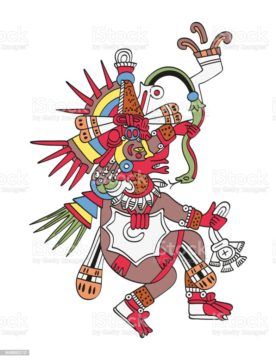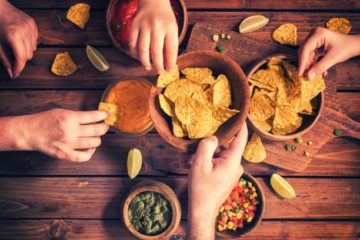by Carol A Westbrook

The new research technician walked into my lab at the University of Chicago, and I introduced her to my research group.
“I enjoyed the walk from home to the lab,” she added. “Everyone in Hyde Park is so friendly! Why just today I stopped to talk to a gardener. He proceeded to tell me about the corn plants he was cultivating. He showed me how he pollinates the plants by hand, and he began to discuss the complicated genetics of corn. “Honestly, Hyde Park is a very impressive place to live. Even the gardeners are highly educated!”
Everyone laughed. “Looks like you came across George Beadle,” someone said. “He’s a Nobel laureate and former president of the University. He’s now retired and doing the research that he always wanted—to determine the origin of the corn plant using genetics.” He likes nothing more than to discuss his theories with anyone who walks by, and spends his day working in his beloved corn fields, where he is doing his research on corn plants.”
This is a true story. George Beadle won the Nobel prize in 1958 for his genetic work on the mold Neurospora, which led to the “one gene-one enzyme” theory, a true breakthrough in understanding the function of DNA. But Nobel prize or no Nobel prize, Beadle’s real passion was the work he started while a graduate student at Cornell University, and that is to solve the mystery of corn’s origin.
Discerning the origin of corn, also called maize, is not merely a rhetorical exercise. After Columbus brought corn to Europe, it spread quickly throughout the world and became one of the three most important food crops in the world, the other two being rice and wheat. Today, the production of maize exceeds even that of rice and wheat. But most of the maize is not used for food. On average in the US, about 45 percent of corn is used for animal feed, 44 percent is turned into ethanol, and only 10 percent is eaten. In fact, over one half of all the calories that we eat in the US come from corn, in the form of everything from high fructose corn syrup, to grain=fed meat, to cooking oil and snacks. Corn has a massively important role, directly or indirectly, in feeding human beings, and insight into its origin will help improve its breeding and production, and provide hybrids that add vigor to crops.
Every domesticated plant has a corresponding wild plant from which it arose, but there did not seem to be any wild counterpart of corn. Corn cannot grow in the wild without the intervention of man. Plant a corn cob and you will soon see that so many seedlings arise that they crowd each other out as they compete for nutrients, and none will survive. Corn kernels must be physically separated and planted individually to produce a healthy corn plant that can propagate its next generation. At the time Beadle started his work on corn there were several theories about the forebears of modern corn. One is that wild corn is extinct; the other is that corn was derived from a wild grass called “teosinte.”
At first glance, teosinte does not seem to be closely related to corn. (Fig. 2).  Both are cereal grains, but differ widely in their characteristics. One the one hand, corn grows on one stalk which supports two cobs, each of which has 500 – 1200 soft kernels; on the other hand, teosinte has multiple fruiting branches, each of which sports a small cob containing 12 kernels, each with a hard fruitcase that makes it almost inedible. Teosinte grows wild, while corn requires human intervention, because it has to be planted as individual seeds. But there are other traits that suggest a closer relationship between the two plants. One is that teosinte and corn have the same number of chromosomes, and the other is that corn and teosinte can easily be cross-bred, producing fertile offspring, suggesting that they are related species.
Both are cereal grains, but differ widely in their characteristics. One the one hand, corn grows on one stalk which supports two cobs, each of which has 500 – 1200 soft kernels; on the other hand, teosinte has multiple fruiting branches, each of which sports a small cob containing 12 kernels, each with a hard fruitcase that makes it almost inedible. Teosinte grows wild, while corn requires human intervention, because it has to be planted as individual seeds. But there are other traits that suggest a closer relationship between the two plants. One is that teosinte and corn have the same number of chromosomes, and the other is that corn and teosinte can easily be cross-bred, producing fertile offspring, suggesting that they are related species.
Folklore and archeological evidence from the regions of Central America where teosinte grows wild, also point to teosinte as the source of corn. First of all, a local name for teosinte is “the mother of corn”. Native folklore from these same areas recognized corn as a gift from the god Quetzalcóatl, (Fig. 20 the feathered serpent.

It all began with a single grain of corn. Legend has it that Quetzalcóatl saw a red ant carrying a seed, and the god asked for it. When the ant refused to give it up, Quetzalcóatl, in the form of a black ant, wrestled this unusual seed away from the red ant, and brought it to the mythical town of Tamoanchan, where the gods resided. There all the gods tasted it, liked it, and passed it on to the humans. The humans grew stronger when they ate the corn. Then Quetzalcoatl helped the Aztec people start their own corn crop. Quetzalcóatl is considered the god of learning, science, and for good reason, agriculture.
Archeological evidence places the origin of corn at 9,000 to 7,000 BCE, the time when cobs first appeared in burial sites. This was during the neolithic period, when ancient humans around the world began to transition from hunter-gathering to agriculture; when animals were domesticated; and when cereal grains were cultivated.
The domestication of maize started with a single seed. Imagine a stone-age woman tending her family’s garden, and coming across a teocinte plant with an unusual characteristic: seeds with a soft shell that, like wheat, can be easily threshed. She planted these seeds and found that the plants which grew from this grain also had this soft seed, and from this she developed a useful strain. This characteristic, called “tunicate seeds” arose from a single mutation of wild teocinte, and is often considered the first step in the transformation of teocinte to modern corn.
It is impressive that the neolithic peoples of Central America had a sophisticated enough knowledge of horticulture that they knew enough to save the seeds and plant them as a crop. It would take many more years for additional desirable mutations to occur in the teosinte-corn crop which were then incorporated into the hybrids until modern corn resulted.This original tunicate seed found in the wild represents the magic seed that Quetzalcóatl gave to the Mexicans, along with the knowledge to improve it by using natural selection.
Corn is a highly nutritious grain; when consumed along with squash or beans, it contains a complete protein diet that is high in calories and oil. This grain can be dried and transported long distances to trade or to feed an army. The large populations, cultural achievements and military success of the Aztecs and Mayans, could not have happened without corn. Corn was soon in demand for trading among neolithic peoples, and by the time Columbus had reached the shores of the New World was found from the mouth of the St. Lawrence River to central Chile; and after Columbus’ visit in 1492, it would be carried to Europe and then the rest of the world.
George Beadle wrote in a 1980 Scientific American article, “the development of corn by the Indians remains man’s more remarkable plant-breeding achievement.” In fact, Beadle was so impressed by this plant breeding achievement that he was determined to reproduce it to see if, once and for all, teosinte was the precursor to modern corn. He had to wait 40 years to do this, after he won the Nobel prize and retired from academics, to accepting a positionas president of the University of Chicago. There he calculated that he had to grow at least 50,000 second-generation crosses of corn and teosinte in order to determine the number of genetic differences between the two. This would be the largest such breeding experiment in modern times. The graduate student mentioned above visited one of those gardens, though most of the work was done in Mexico, at the International Maize and Wheat Improvement Center near Texcoco, which had a climate more suitable to growing teosinte.
At the conclusion of his maize experiment, Beadle found that most of the crosses gave plants that were intermediate between maize and teosinte, as expected. But 1 in 500 were found to be identical to the trait of one of the parents. Using the mathematics of Mendelian genetics, Beadle calculated that there were only 5 or 6 gene differences between the two plants! These included large cobs, soft seeds, and cobs on a single stalk, and so on. This demonstration was so compelling that most scientists now agree that teosinte is the wild progenitor of maize.
Since then, the genomes of corn and teosinte have been sequenced and have confirmed that the two plants are variants of the maize species. Sequencing has also been used to confirm that the small cobs found in other archeological sites are intermediates in the domestication of teosinte.
It took 6-7 millenia of selective breeding to convert teosinte to today’s corn. It took Beadle 3 or 4 years to do the same. Today, with modern genomics methods, we can sequence a new variant in a few weeks and easily identify the genes of interest.
Recently, is has become possible to insert a foreign gene from another species into the maize genome to give it additional characteristics. This practice, called genetic modification, or GMO, has become widespread. Corn is the most commonly grown grown in the United States, and I was surprised to learn that most of it is GMO. The most common GMO corn contains the gene from Bacillus thuringiensis (Bt). (Bt) corn produces proteins that are toxic to certain insect pests but not to humans, pets, livestock or other animals or beneficial insects such as ladybugs.

This reduces the need for spraying insecticides while still preventing insect damage. While a lot of GMO corn goes into processed foods and drinks, most of it is used to feed livestock, like cows, and poultry. I think about this as I sit here, eating a corn chip which was fried in corn oil, dipped into some cheese made from the milk of a corn-fed cow.
 In a few days, we will celebrate Thanksgiving. Corn will appear on our table, as it did on the table of the first ThanksFig giving, many years ago. This year I will think about the origin of corn. It all started with a seed, a gift from Quetzacoatl to the ancient people of Mexico, who cultivated it and gave it to the world. This is Maize.
In a few days, we will celebrate Thanksgiving. Corn will appear on our table, as it did on the table of the first ThanksFig giving, many years ago. This year I will think about the origin of corn. It all started with a seed, a gift from Quetzacoatl to the ancient people of Mexico, who cultivated it and gave it to the world. This is Maize.
